Chances are, you have at least one 2 1/2” inlet
So, you’re looking for a new cap or plug for that thing marked “AUTO SPKR,” “FIRE DEPT CONN,” “AUTO SPKR/STANDPIPE,” or simply “STANDPIPE.” You’ve pulled out your tape measure. Maybe you’ve even looked at guides that tell you how to size FDC break caps and plugs (or the fire department connection’s inlets).
After a few careful measurements, you’re sure you need three-inch fire department connection caps and plugs. Unfortunately, you’re probably about to place the wrong order. In this guide, we explain why—and help you get the right FDC fire equipment with the least effort, providing answers to some frequently asked questions, such as:
- My FDC is stamped “AUTO SPKR 300.” Which fire department connection plugs or caps do I need?
- The FDC’s inlet, plug, or cap has a 3” diameter from thread to thread or end to end. What size cap or plug do I need?
- What’s the most accurate way to size a fire department connection’s inlet, plug, or cap?
- I’ve measured the inside waterway and I have my size. What do I do now?
- I know what size and thread type I have. Can you tell me what to look for?
- I’m still not sure what I need. What else can I do?
Browse our selection of 2 1/2” plug and chain assemblies, various sizes of breakable caps, all of our plugs, or our complete selection of FDC fire equipment.
My FDC is stamped “AUTO SPKR 300.” Which fire department connection plugs or caps do I need?
AUTO SPKR 300” doesn’t contain a model number or a size. Instead, the 300 in “AUTO SPKR 300” refers to pressure: your FDC is designed for pressures as high as 300 pounds per square inch (PSI). It’s extremely common on FDCs with two inlets (or “Siamese” FDCs). Their inlets are usually—but not always—in 2 1/2” sizes.
In sum: “AUTO SPKR 300” won’t help you arrive at the right size for FDC inlets, caps, or plugs. Read on to discover which size and threads you need.
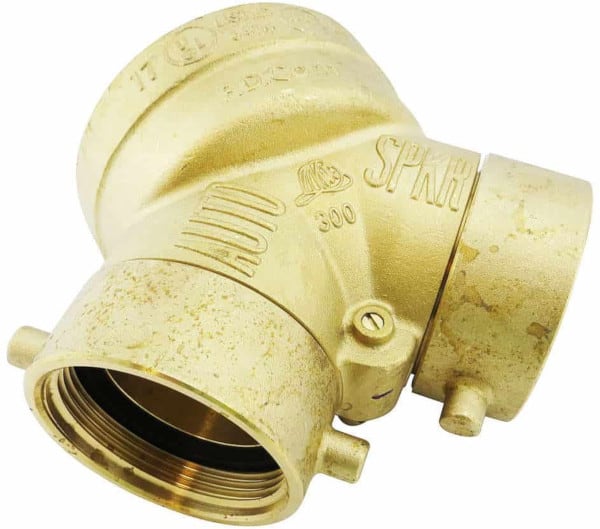
The FDC’s inlet, plug, or cap has a 3” diameter from thread to thread or end to end. What size cap or plug do I need?
It’s probably a 2 1/2” inlet with National Standard Thread or National Hose (NST/NH)—but don’t order just yet. Often, consumers who end up with measurements of 3” or 3 1/2” have held their measuring tape on the outside edge of the swivel or placed it between the inlet’s threads. Neither of these measurements has any bearing on the inlet’s size, or on the size of FDC caps and plugs. The same goes for measurements taken along the outside diameter of caps and plugs. Read the next section for accurate sizing guidelines.

What’s the most accurate way to size a fire department connection’s inlet, plug, or cap?
For those who have a spare FDC plug—not cap—handy, measure the FDC the easy way: starting with the threaded end of the plug up, place the hooked tab of a tape measure against the threads. Note the distance between the threads at the widest point (not including the rim or the outside of the plug).
Otherwise, it’s time to figure how big the FDC’s inside waterway is. Follow these steps:
1. Rotate the swivel, looking for the small set screw near its edge.
2. Remove the screw. Place a small container under the swivel.
3. Slowly slide the swivel off of the FDC’s body, using the container to catch small ball bearings that will slip from the body and the swivel during removal.
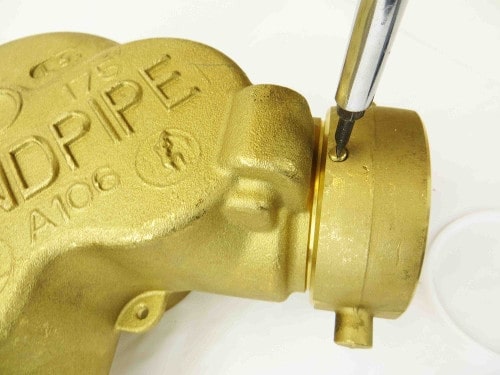
4. Set the swivel and bearings aside.
5. Measure the diameter of the swivel at its narrowest point—that’s the FDC’s size.
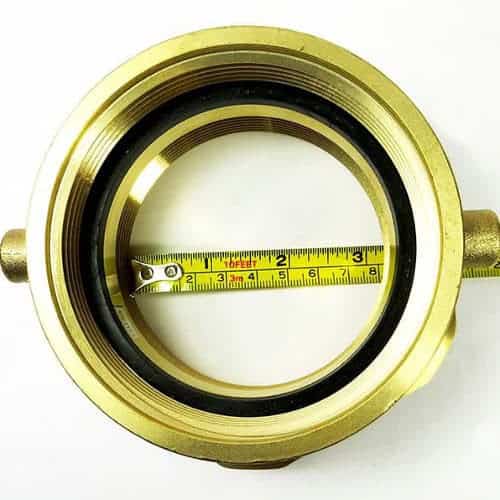
6. Place the swivel on the body with the hole facing up. Align the groove on the FDC’s body with the hole.
7. Insert all ball bearings into the hole reserved for the screw. Reattach and tighten the set screw.
8. Rotate the swivel. If properly reattached, it should spin smoothly.
I’ve measured the inside waterway of the FDC and I have my size. What do I do now?
If the inside of the inlet doesn’t have threads—if it’s smooth with two hooks on its face—it’s called a Storz connection, and it’s most likely 4” or 5” in diameter. Storz caps in these sizes are readily available.
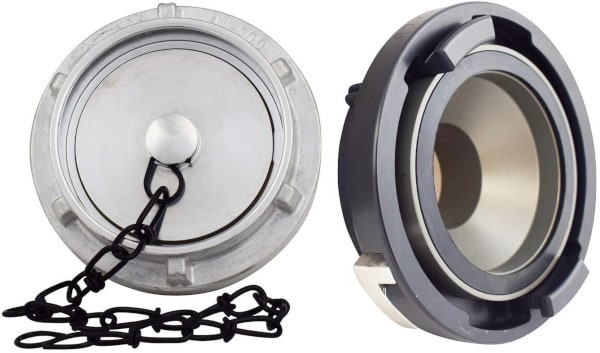
If the inside of an inlet resembles a washer or the sides of a spigot—that is, if it has threads—consumers have two options:
- The easy way: install breakable caps. Because caps sit flush with the swivel’s outside edge—and don’t engage with the threads—buyers don’t need to figure out which threads the inlet uses. However, these caps are only an option if local fire codes allow them (most do) and if the swivel has pin lugs. Without these small, cylindrical nubs, the caps won’t stay on.
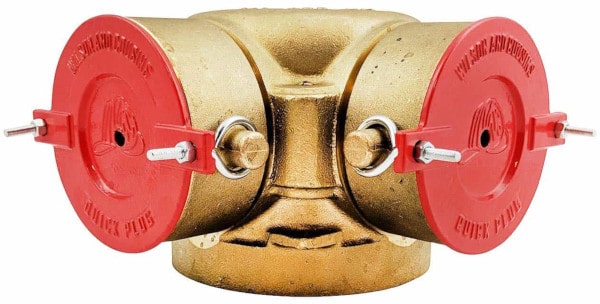
- The other way: use a threaded plug and chain. If the swivel uses flat, fin-like “rocker lugs,” the FDC will likely need a plug that engages with the inlet’s threads. The thread type is critical: most have a unique angle (pitch) and spacing. And with few exceptions, different fire hose thread types aren’t interchangeable. It’s very likely that your FDC uses National Standard Thread and National Hose (NST/NH), a common type with more than a century of use in fire protection. But some fire departments and cities opt to use fire hoses with threads that don’t fit NST-threaded FDCs.
In the following sections, we’ll explain how your location (and FDC size) can streamline the search for caps and plugs. However, it’s a good idea to simply ask local officials which sizes will connect to their fire hoses. An authoritative answer from a state fire marshal, code experts, or your local fire department can make this task much easier.
I have a 2 1/2” swivel. Which threads does it use?
You’re in good company: 2 1/2” is a common size for fire department connections throughout the United States. In 2004, 43 of America’s 48 most populated cities used 2 1/2” hoses with fire hoses and hydrants—and those same 2 1/2” connections are likely used for their local FDCs.
Overwhelmingly, though, 2 1/2” FDCs have NST-threaded inlets, meaning that:
- Buyers with pin-lug swivels can purchase 2 1/2” breakable caps
- Rocker-lug FDCs may use threaded 2 1/2” plugs
However, a handful of American cities use 2 1/2” FDCs without NST threads, including:
- Oklahoma City, Oklahoma
- New Orleans, Louisiana
- Cleveland, Ohio
Breakable caps can still work here—as will adjustable plugs that accommodate different thread types. However, buyers may need to place a special order if their FDC requires a standard plug. For those who aren’t sure which thread type they have (or who can’t find what they need online), QRFS is happy to help: call 888-361-6662 or email support@qrfs.com.
I don’t have a 2 1/2” swivel. Which threads does it use?
For less-common thread sizes, check the following:
- Does it lack threads? If so, it likely uses threadless Storz connections.
- If it has threads: is it smaller than 2 1/2”? A handful of cities use slightly smaller (but threaded) connections with commercial fire department connections. However, if it has an inside waterway of 1 1/2”—as many do—it’s likely an NST-threaded FDC for a residential building. Take a look at 1 1/2” NST plug and chain assemblies.
If it has threads: is it larger than 2 1/2”? If so, is the FDC located in San Francisco, California or New York City, New York? These jurisdictions use unique thread standards. However, they’re common enough that fire protection retailers often carry a supply of compatible caps and plugs. Color-coded NYFD-threaded plugs are available for fire sprinkler systems, standpipe systems, and combination systems. 3” breakable aluminum caps can fit 3” pin-lug FDCs in both cities, while plastic adjustable plugs can fit both 3” and 3 1/2” inlets.
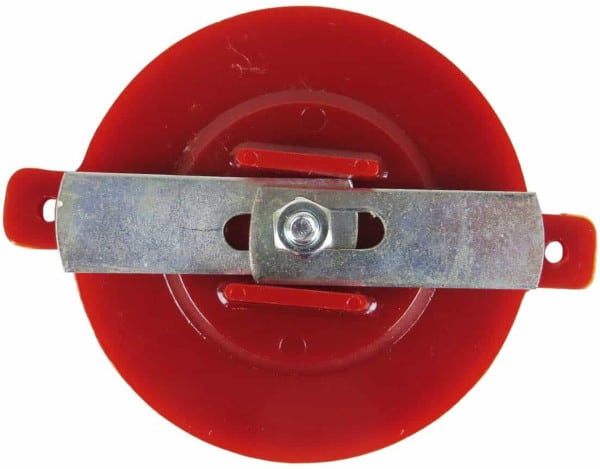
I know what FDC size and thread type I have. Can you tell me what to look for?
QRFS carries a selection of caps and plugs made from a range of durable materials, including aircraft-grade aluminum, brass, plastic, and more. Our stock features fire department connection caps and plugs made for specific sizes, thread types, and swivel styles, including:
No threads, two hooks: 4” and 5” Storz caps.
NST threads on a rocker-lug swivel:
- 1 1/2”: Residential 1 1/2” NST plug and chain assemblies.
- 2 1/2”: Threaded 2 1/2” NST plugs or an Adjust-a-Plug
NST threads on a pin-lug swivel:
- 1 1/2”: Residential 1 1/2” NST plug and chain assemblies.
- 2 1/2”: A threaded 2 1/2” NST plug, an adjust-a-Plug, or a 2 1/2” breakable cap
Non-NST threads:
- In New York City: NYFD-threaded 3” plugs, plastic adjustable plugs (if compatible with local fire code and color-coding requirements), or 3” breakable aluminum caps (pin lug swivels only)
- Elsewhere: 3” breakable aluminum caps (pin lug swivels only) or plastic adjustable plugs. Plugs with custom threads are available by special order—call us at 1 (888) 361-6662 or email support@qrfs.com.
I’m still not sure what I need. What else can I do?
Getting the right size and thread for FDC fire equipment is tough—but we’ve helped countless customers find a solution. If you’re stuck, we’re happy to help. Again, call us at +1 (888) 361-6662 or email support@qrfs.com.
This blog was originally posted at blog.qrfs.com. If this article helped you, check us out at Facebook.com/QuickResponseFireSupply or on Twitter @QuickResponseFS.


